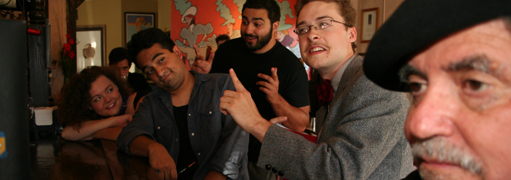Art and science are usually viewed as separate, walled-off worlds. It’s been said that art, while influenced by philosophy and strategy, maintains steadfast ground not in the head, but in the muse-directed heart and gut. It also goes that science lives in the brain, plodding through cerebral pathways to carve out theories and observe minute truths. The problem with this stereotype is that it just isn’t true. Art and science lease equal space in the head and heart, and they influence each other as much as they are each inspired by beauty and logic.It’s in this mindset that Steve Martin’s (yes, that Steve Martin) Picasso at the Lapin Agil e takes the stage. Set in 1904 Paris at a historic bar that Picasso actually frequented (the Lapin Agile , or the Nimble Rabbit), this fictionalized play thrusts the artist into the same room as Albert Einstein, along with an assemblage of other bar patrons. The witty and sharp script winds through notions of sex, romance, genius, modernism, commercialism, fame, and, of course, art and science. Obviously, its author is someone who esteems the latter two with equal ferocity.Aux Dog is a relatively new theater, and the actors in this production are fairly new as well. The greenness of the cast is apparent in Picasso , but that doesn’t keep the production from being sweet, exuberant and highly entertaining. The actors ricochet off each other like old friends. As a group, they have a presence that transfixes, and by the end of the show, you feel like part of the gang. We enter the scene along with the bartender and owner, Freddy (Aaron DeYoung), who’s opening shop. He’s soon followed by an elderly customer, Gaston (Joe P. Martinez), a waitress who’s also Freddy’s girlfriend, Germaine (Jenn Daugherty), and a 25-year-old Einstein (Graham Gentz). It’s when Einstein enters that the play starts moving. Gentz is charismatic and hilarious. He feels like the most experienced of the bunch, maintaining a slight German accent and conducting himself, from his loafers to his frenetic fingers, with poise and consistency. He’s a natural comedian, delivering many of the play’s funniest lines with no wink and no nod, but with considerable ease.Even though the play is named for Picasso, it’s Einstein who carries the role of protagonist. Picasso (Paul Rodriguez Jr.), who was 23 at the time, was known for his promiscuity. That trait takes center stage in Martin’s version of the man. But if Picasso is the embodiment of lust—both of the flesh and of the paint brush—Einstein is knowledge incarnate. The two repel each other like parallel magnets. Each claims he will make the greatest contribution to the 20 th century—Einstein in his special theory of relativity, which has yet to be published, and Picasso in his Les Demoiselles d’Avignon , three years before it is completed. Ultimately, they realize they may both be correct.Rodriguez is charming as the temperamental, pleasure-seeking artist. His character is written somewhat superficially, but Rodriguez fits the bill with whimsy, bringing humor to Picasso’s dalliances and pretensions. Other patrons come and go from the bar, adding their own distractions and insights. Of particular note are Sagot, Picasso’s art dealer, played by Christy Lopez, and Charles Dabernow Schmendiman, a young inventor, played by Nick Ganjei. Lopez bursts onto the scene like a hurricane, consuming the entire stage with her boisterous presence. Her character is loud and obnoxious, more interested in her own stories than anyone else’s and cackling constantly as though drunk. Lopez fills her out brilliantly. She brings the character to life and, irritating as Sagot may be, portrays her with a warmth and flair that makes you sad when she exits. Likewise, Ganjei infuses his arrogant, carefree inventor with bravado. He commands the room without being over the top, and he does it with a grin that makes you love the guy.The set design, created by John van der Meer, is delightful. The stage is a perfect cross-section of a bar. You almost expect to turn around in your seat and see the other side. A set of steps rises outside the bar’s door, leading to a street outside. It’s all visible from a large barroom window, allowing the audience to see feet walking past and to know when a new patron is about to enter. It’s a subtle technique that makes the bar feel all the more real. Director Beth Welt has done a spot-on job with this show. The comings and goings and conversations of the characters feel natural and effortless, a certain sign that a lot of effort went into the production. Picasso at the Lapin Agile is smart, engaging and will get even the stodgiest viewer to crack a smile. The cast’s enjoyment of the play is infectious. In short, it’s just plain fun.
Picasso at the Lapin Agile Runs through Sept. 26 8 p.m. Friday and Saturday; 2 p.m. SundayAuxiliary Dog Theatre3011 Monte Vista NETickets: $14254-7716, auxdog.com










